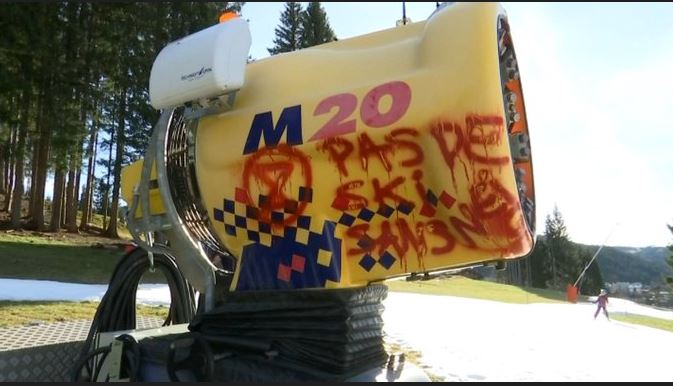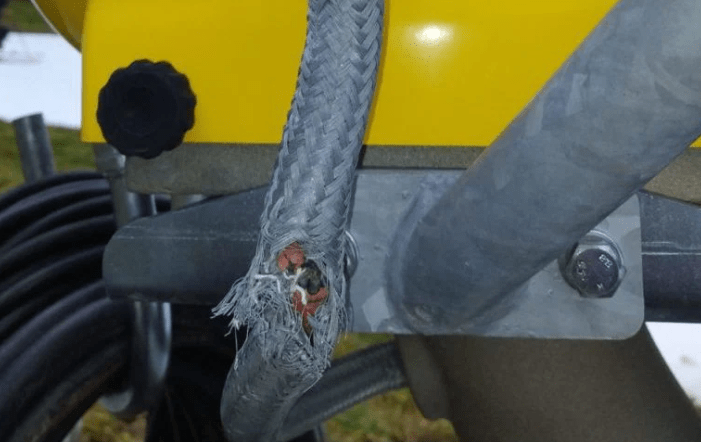
Reports have been coming in from across the Alps for several months now of climate activists repeatedly damaging snow cannons in European ski resorts. In Swiss and French ski resorts, such as Villars, Les Diablerets, Verbier, Les Gets, and La Clusaz, damage to snow cannons has been reported across December and January. Sometimes confessions were posted on militant websites, and some of these ‘eco warriors’ claim to be members of groups such as Extinction Rebellion. The organization’s circled hourglass logo was spray-painted on the snow cannons. The local Extinction Rebellion group in Annecy denied involvement, saying: “We are not eco-saboteurs, so this is clearly not our mode of action and it has never been discussed within our collective.”
- Related: How to Be a More Sustainable Skier
In a recent anonymous interview with a Swiss newspaper, a climate activist identified only as ‘Joseph,’ who admits to having been behind such an act of vandalism, said, “What we want is to finally highlight the broader problem. Snow guns are electricity, destructive water reservoirs, and they are also a symbol. At first, skiing was going up to the top and down yourself. In the last thirty years, it has become an industry that has brought roads, parking lots, hotels, gentrification, infrastructure everywhere. We don’t see it because no one goes to the Portes du Soleil in summer – an open-air construction site. But the result is a huge impact, all year round, on people and biodiversity while it is the last preserved areas that remain. Instead, real estate has created entire villages of identical, empty houses, doomed to abandonment. I’m sorry, but basically, living in the mountains is not that. Before this mass skiing industry, which is a recent phenomenon, it was fine in the mountain.”
Questions by the reporter on how the destruction of snow cannons is justifiable when they only account for about 14% of the energy consumption of a ski resort and keep becoming more energy efficient are being brushed aside as just obscuring the real issue and delaying the inevitable, which is an end of the ski industry. The anonymous activist admits to being a local and is disgusted by the explosion of real estate across his home village and the foreign tourists who come with no regard for the environment or their carbon footprint, destroying the natural habitat for animals and driving up real estate prices and pricing locals out off their own homes. The activist is reportedly an environmental engineer and admits that he had long hoped wind and solar power could save the planet but now believes that more drastic action must be taken to save the planet.
While many of his arguments carry a genuine environmental concern, many of his complaints in the interview seem to narrow down to not wanting to share the mountain with out-of-towners. For these activists, snow cannons are the ‘symbol of the absurdity of snowsports’ in the present day. In their opinion, skiing is an indulgence that has no place today when steps are being taken worldwide to reduce emissions.

Nevertheless, it is important to question how appropriate it is to artificially produce vast amounts of snow. Snow cannons have become a staple in winter sports, providing artificial snow when Mother Nature falls short. Fake snow has been vital this winter for European resorts, where snowfall was below average, to ensure a continuous operation from December to April. Modern snow cannons are becoming increasingly eco-friendly. They now use recycled water, and proponents argue that the economic gain from the guaranteed snow outweighs the environmental cost as it secures millions of jobs in these remote villages. Many snow cannons are now powered by sustainable energy and use the natural cooling from water evaporation to operate, making the overall energy requirement even smaller. They do, however, continue to use vast amounts of water.
In September, activists occupied a water reservoir in La Clusaz that was being constructed to provide water for snow cannons in the resort. The activists refused to leave and successfully delayed the project. The activist group called “Mountain Wilderness” said: “These projects are a source of division and conflict and given their financial and ecological costs, they can no longer do without real democratic consultation prior to their design.”
Hydrologist Carmen de Jong has been petitioning for almost two decades against using snow cannons and claims that snow cannons are “drying out” the Alps. A claim Laurent Reynaud, head of the union of ski lift operators, disputes. He insists that artificial snow is returned to the water table when it melts in the same way as natural snow. A statement TechnoAlpin, the world’s leading snow cannon manufacturer, would support. The company stresses explicitly that snow cannons don’t ‘consume’ water but rather ‘use’ water, which is returned 100% to nature. One cubic meter of water produces 2.5 cubic meters of snow. So for a snow depth of 30cm across one hectare of the ski area, you use 1.000 cubic meters of water, which is less than a third of an Olympic-sized swimming pool.
In response to the actions of these activists, some ski resorts have increased security around snow cannon systems to prevent further damage. Some have also installed cameras and other security measures to deter potential attackers.